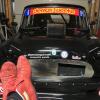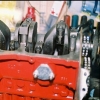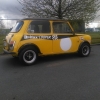Ok So Re-Torque Head? Difinitive Answer Please
#1

Posted 09 February 2016 - 10:58 PM
#2

Posted 09 February 2016 - 11:14 PM
Torque in should be done evenly and in steps. Smaller steps as you get to final torque.
If 11 stud with a bolt I tend to bring that to final torque last.
#3

Posted 09 February 2016 - 11:34 PM
Torque to standard figure in increments. Start at 20 ft.lb, then 30, then 40 and finally to 50.
Run engine and drive car for two or three full heat cycles and allow to completely cool.
Back each head nut off in turn by 1/2 of 1 full turn doing it to each nut in the correct sequence and re-torque to 50. Make sure each nut is correctly re-torqued before doing the next one. if 11-stud do the 11th last of all to 25 ft.lb.
Re-torque the rocker shaft nuts to 25 (or just re-tighten by hand.
Re-adjust valve clearances to 0.012" unless using higher-lift rockers in which case set to 0.015".
Run engine. Enjoy ![]() .
.
#4

Posted 10 February 2016 - 06:31 AM
Torque to standard figure in increments. Start at 20 ft.lb, then 30, then 40 and finally to 50.
Run engine and drive car for two or three full heat cycles and allow to completely cool.
Back each head nut off in turn by 1/2 of 1 full turn doing it to each nut in the correct sequence and re-torque to 50. Make sure each nut is correctly re-torqued before doing the next one. if 11-stud do the 11th last of all to 25 ft.lb.
Re-torque the rocker shaft nuts to 25 (or just re-tighten by hand.
Re-adjust valve clearances to 0.012" unless using higher-lift rockers in which case set to 0.015".
Run engine. Enjoy
.
Yes, though I do them with Oil Studs / Nuts and with the particular Studs you are running, no more than 45 ft / lb torque.
#5

Posted 10 February 2016 - 08:59 AM
Torque to standard figure in increments. Start at 20 ft.lb, then 30, then 40 and finally to 50.
Run engine and drive car for two or three full heat cycles and allow to completely cool.
Back each head nut off in turn by 1/2 of 1 full turn doing it to each nut in the correct sequence and re-torque to 50. Make sure each nut is correctly re-torqued before doing the next one. if 11-stud do the 11th last of all to 25 ft.lb.
Re-torque the rocker shaft nuts to 25 (or just re-tighten by hand.
Re-adjust valve clearances to 0.012" unless using higher-lift rockers in which case set to 0.015".
Run engine. Enjoy.
Perfect thank you ever so much and everyone else 😊😊😊😊
#6

Posted 10 February 2016 - 09:21 AM
Put the emphasis on the sentence 'allow to completely cool'
If you retorque when hot, you'll snap a stud
I never go over 40lbs/ft (54 Nm) for the head bolts.
i've seen people going to 54 lbsft (73Nm) because that was quoted on some old books, and then snap studs..
#7

Posted 10 February 2016 - 03:42 PM
50ftlb and I've never snapped a stud, but then again, I know when something does not feel right so back off before anything does go pop...
You're more likely to pull the thread out of the block than snap a stud.
#8

Posted 10 February 2016 - 05:25 PM
With the smattering of torque values through this thread, I though it might be best to also mention the supplier's low-down on the studs that the OP has bought;--
"and they torque to 42lb per sq ft."
https://www.minispar...|Back to search
https://www.minispar...|Back to search
I'll just say from my own experience, that I've found these to be a different stud to the OE ones, while I have been able to pull those down to 50 ft / lbs all day, these new ones I've broken before getting to 50. Why did I try them to 50? Well, they do carry the OE Part No!
<Edit: The OE ones had quite a distinguishable taper on the UNF end, the new studs have no taper.
The figure of 45 that I quoted it seems is now incorrect. I got that from 'Instructions' that were included with a set of these studs that were supplied to me a year back. >
Edited by Moke Spider, 10 February 2016 - 06:23 PM.
#9

Posted 10 February 2016 - 07:01 PM
And to confuse things you can of course get EN24 rated studs that go even higher on the torque range ..
#10

Posted 10 February 2016 - 07:19 PM
Should the rockers be slackened off before the procedure starts, I know your only doing one stud at a time and only winding off a small amount but would the spring pressure effect the final figure?
#11

Posted 10 February 2016 - 10:40 PM
A question. What is the backing off meant to achieve?
I have never ever come across this advice on any engine I have worked on.
The only time I have needed to back anything of is when building cycle wheels to remove any twisting in the spoke.
Can't see it being for taking any twist out of anything.
Why would it not be mentioned on engines that require an angular retorque after a heat cycle?
Just trying to see what gain there is over just checking the torque after a heat cycle?
#12

Posted 10 February 2016 - 11:13 PM
#13

Posted 11 February 2016 - 08:13 AM
So one thing I've always thought about is most of the re-torquing guides are written in the same sequence as coopermans above.
Should the rockers be slackened off before the procedure starts, I know your only doing one stud at a time and only winding off a small amount but would the spring pressure effect the final figure?
Can't say I've ever bothered backing the rockers off, but I always back the nuts off before going again.
<Edit for clarification>
Edited by Moke Spider, 11 February 2016 - 08:46 AM.
#14

Posted 11 February 2016 - 08:42 AM
The backing of was also advised in the fiat /lancia AR and fire engines, like above, I guess its something to do with friction.
#15

Posted 11 February 2016 - 06:50 PM
The spring pressure is negligible compared to the tension in the head studs. The only reason for backing off valve adjusters would be to prevent nasty things like spring bottoming or valve to piston contact on some engines (not A series) if the retorquing compressed the gasket significantly. But it will not. If you are curious, measure valve clearances before and after (before final adjusting), and find out just how many thou of extra gasket compression there is. It will not be much, but depends on which kind of gasket you are using.
1 user(s) are reading this topic
0 members, 1 guests, 0 anonymous users





















